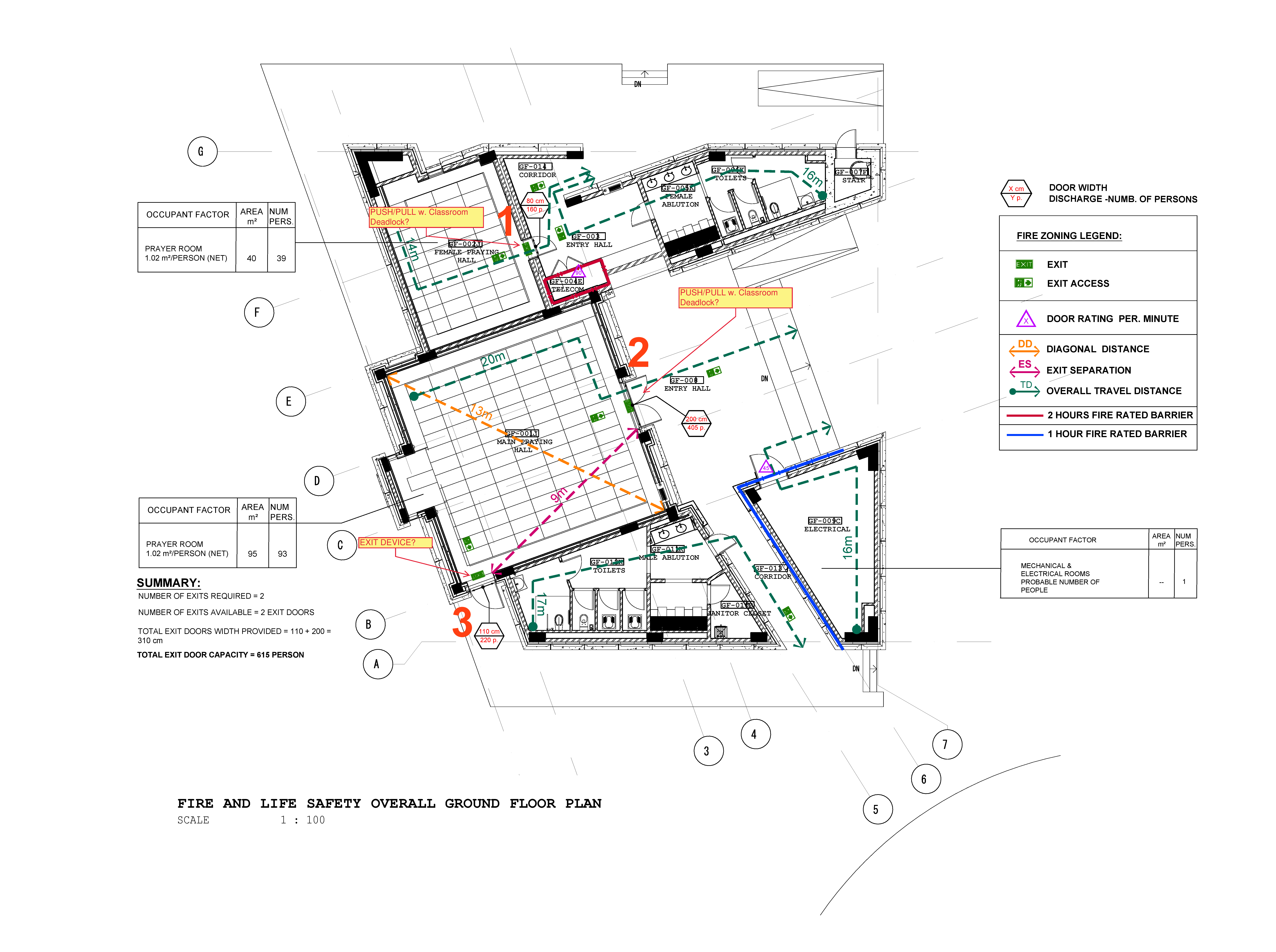I don’t know how almost a year has gone by, but last November I published a post asking readers to apply their knowledge and answer some questions about what would be required by code for a high school music classroom. A lot of people told me how much they liked the post and that it was a great way to learn.
The other night I received an email from Rob Kalar of Dar in Dubai, and I thought it would be a great example to share here. This building is a mosque, and the 3 doors in question are numbered 1, 2, and 3. The occupant load for each room is shown to the left of the two prayer rooms. I’ve added some questions below the floor plan. (It’s kind of hard to navigate the plan with the zoom feature, but you can click on the floor plan link to make it larger.)
Assuming that the adopted code is NFPA 101-2018 and the mosque is classified as an assembly occupancy…
- Is Door 1 allowed to have push/pull hardware and a classroom function deadbolt (thumbturn retracts deadbolt but does not project it)? If yes, are there other criteria that would apply?
- Is Door 2 allowed to have push/pull hardware and a classroom function deadbolt? What would be required for the inactive leaf?
- Is Door 3 required to have panic hardware? Could this door have a double-cylinder deadbolt instead?
How would the answers change if the adopted code was the 2018 International Building Code?
Here are some links in case you need help:
- Decoded: Deadbolts in a Means of Egress
- Decoded: Key-Operated Locks
- Decoded: Flush Bolts and Coordinators
- Video: Flush Bolts and Coordinators
- Decoded: Panic Hardware Refresher
- Video: Where is panic hardware required by code?
Leave your answers in the reply box, and show your work! 🙂 I’ll do a follow-up post on Thursday. (Here it is!)
You need to login or register to bookmark/favorite this content.






Door 1 should have no problem receiving a classroom deadbolt to go along with a push pull, I can’t find anything else that would be the requirement however.
Door 2 should be mostly the same as door 1, neither have more than 300 people. However, it should not have any flush or surface bolts.
Door 3 could receive a double cylinder deadbolt, so long as it has a sign stating that it is to remain unlocked during periods of occupancy. This is because it is low occupancy as well as a religious building.
Under the IBC-2018
Door 2 could seemingly have an approved flushbolt, since it has no knob.
It is less clear whether a classroom function deadbolt would be allowed on egress doors in that situation. It probably would be though, since locksets with internal locks would be allowed, and they would still meet the single-operation minimum.
OK so In the great book of 101, Which is not friendly it you do not use it,
Door one can have ” have push/pull hardware and a classroom function deadbolt” because occupant load is under 100.
It is not an exterior door, so sign not required
Door 2 Occupant load is under 100, so panic hardware is not required.
So it seems ” push/pull hardware and a classroom function deadbolt” would be allowed.
Inactive leaf Not sure, seems like it should be released somehow???
It appears 101 requires it to release
Door 3 does not have to be panic hardware.
And seems like if it had a dead bolt, it would have to be unlocked when the room is occupied.??
Ok, that is my best 101 guesses.
Hi Lori,
I know the point of this exercise is an issue of life safety but I can’t help but point out an often-missed accessibility item on these plans. Maneuvering clearance issues abound in this example but the door I want to draw attention to is Door #1. Upon first blush, I think a lot of people would not see anything wrong with this door in terms of accessibility but, if relative scales are to be believed, (and assuming this door has a latch and a closer) this is actually a recessed door and needs additional consideration for maneuvering clearances. You can see a picture of a recessed door maneuvering clearance in everyone’s favorite state accessibility code, CBC Figure 11B-404.2.4.3(c).
Thanks for pointing that out Leslie! Since this building is outside of the US, it probably doesn’t have to comply with the US accessibility standards, but it’s good to always be on the lookout for maneuvering clearances issues. There’s more on recessed doors in this post: https://idighardware.com/2012/09/recessed-doors/.
– Lori